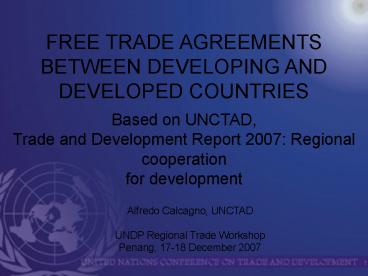FREE TRADE AGREEMENTS BETWEEN DEVELOPING AND DEVELOPED COUNTRIES - PowerPoint PPT Presentation
1 / 18
Title:
FREE TRADE AGREEMENTS BETWEEN DEVELOPING AND DEVELOPED COUNTRIES
Description:
New agreements are bilateral rather than plurilateral ... feel forced to conclude these FTAs for fear of losing competitiveness vis- -vis ... – PowerPoint PPT presentation
Number of Views:99
Avg rating:3.0/5.0
Title: FREE TRADE AGREEMENTS BETWEEN DEVELOPING AND DEVELOPED COUNTRIES
1
FREE TRADE AGREEMENTS BETWEEN DEVELOPING AND
DEVELOPED COUNTRIES
Based on UNCTAD, Trade and Development Report
2007 Regional cooperation for development
Alfredo Calcagno, UNCTAD UNDP Regional Trade
Workshop Penang, 17-18 December 2007
2
Present trends in regional trade agreements
3
The number of trade agreements notified to WTO
has increased rapidly since the 1990s. New
agreements are bilateral rather than plurilateral
Cumulative number of trade agreements, by type
4
they consist of Free Trade Agreements rather
than Custom Unions or Common Markets
Cumulative number of trade agreements, by degree
of commitment
5
and they are increasingly signed by countries
from different regions and with different levels
of development.
Cumulative number of trade agreements, by
economic classification of members
6
Market access vs. policy space?North-South trade
agreements pose a dilemma to developing countries
- Developing countries may wish to secure or
increase market access to developed countries - They may seek to obtain concessions that are not
granted to other countries - Countries may feel forced to conclude these FTAs
for fear of losing competitiveness vis-à-vis
other developing countries that have entered into
FTAs with the same major trading partner. - However, developing countries are often unable to
derive the full benefits of improved market
access because of limited supply capacity,
protracted subsidies to sensitive sectors in
developed countries and because their firms are
frequently unable to comply with restrictive
rules of origin.
7
At the same time, North-South agreements reduce
the options for developing countries to carry out
proactive policies
- Special and differential treatment is replaced by
full reciprocity - Developing countries must accept deeper
liberalization on trade in goods and services
than has been agreed in WTO. - North-South FTAs include provisions that extend
beyond WTO rules in areas such as foreign
investment, intellectual property rights,
competition policy and government procurement
(Singapore issues) - They also cover areas that have been excluded
from trade multilateral negotiations, such as
rules on labour and environment. - Developing countries have to abandon capital
controls and positive discrimination subsidies
to agriculture in developed countries are not
affected.
8
Trading partners and composition of trade
9
The composition of the trade of developing
regions depends crucially on their trading
partners
Composition and direction of exports, selected
regions, 2003-2005
10
The composition of the trade of developing
regions depends crucially on their trading
partners
Composition and direction of exports, selected
regions, 2003-2005
11
The composition of the trade of developing
regions depends crucially on their trading
partners
Composition and direction of exports, selected
regions, 2003-2005
12
Mexico and NAFTA
13
In Mexico, foreign trade in merchandises grew
faster than manufacturing value added.
Trade and value added in manufactures, 1984-2005
(Billions on dollars)
14
Real GDP growth rates in Mexico and Latin
America, 1971-2006 (per cent)
1971 1981 1989 1994 2001 1981
1988 1993 2000 2006 Mexico 6.4 0.6 3.9 3.6 2.3 L
atin America (excl. Mexico) 5.5 2.0 1.6 2.9 3.
4
Source UNCTAD secretariat calculations, based on
UNCTAD Handbook of Statistics database.
15
Mexico NAFTA-related performance indicators(Per
cent)
1990 1994 2001 2005/06 Manufactured exports as
of world manufactured exports 0.5 1.4 2.7 2.1 To
tal manufactured exports as a share of
GDP 5.2 11.8 22.6 22.9 Manufactured exports to
NAFTA as a share of GDP 4.0 10.6 20.8 20.5 Manufac
turing value added as a share of
GDP 20.6 18.2 19.2 17.5 Inward FDI stock as a
share of GDP 8.5 7.9 22.6 27.3 Ratio of gross
fixed capital formation to GDP 17.9 19.4 20.0 19.3
GDP per capita as a of US GDP per capita
(PPP) 26.9 27.1 26.1 24.4 Inflation 29.9 7.1 4.4 4
.1 Mexican nominal wage as a of US nominal wage
(in manufactures) .. 17.5 16.9 17.3
Source UNCTAD secretariat calculations, based on
UNCTAD Handbook of Statistics database UN
COMTRADE World Bank, World Development
Indicators database UNCTAD, WIR database and
Instituto Nacional de Estadística, Geografía e
Informática (INEGI) database. Note To ensure
data comparability, the definition of
manufactures in trade data follows the ISIC
classification of industrial statistics. It
therefore includes processed primary products in
addition to manufactures as defined in trade
statistics.
16
In Mexico,
- Remarkable trade expansion did not lead to growth
acceleration - Higher inward FDI did not lead to higher
investment rate - Wages, income distribution, illegal emigration
and poverty remained largely unchanged - A considerable proportion of employment was
created in low-productivity or informal
activities, mainly in services - Traditional agriculture was adversely affected by
imports of subsidized products from the US, with
important employment reduction.
17
In conclusion,
- In North-South deep FTAs, developing countries
usually accept conditions they refuse in
multilateral negotiations - The gains for developing countries from improved
access through FTAs are not guaranteed, and may
be short-lived, but the loss of policy space is
certain - The composition of exports and their linkages
with the rest of the economy matter as much (or
more) as the volume of trade - FTA with developed countries tend to reinforce
the specialisation in natural resources or in
low-skill and low technology-intensive
manufactures - Intra-regional trade can often be more conducive
to diversification and industrial upgrading than
extra-regional trade.
18
Decisions related to trade and finance
integration are not just about trade and finance
they have an impact on the ability to carry out
development policies in a wide range of economic
matters. Trade integration should be part of a
broader development strategy.































